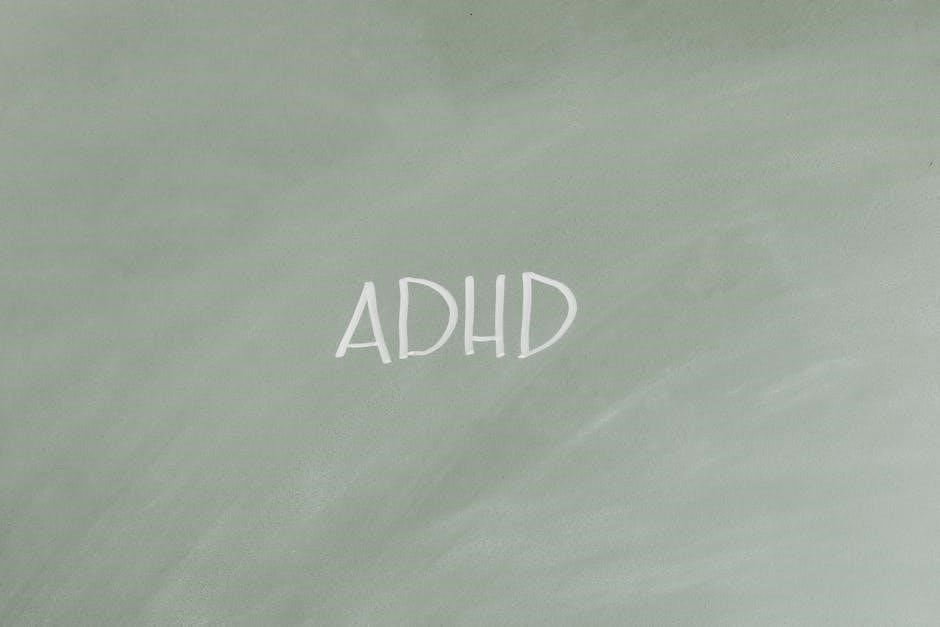The Mental Health Symptom Checklist is an effective tool for assessing and tracking mental health symptoms. It helps identify individuals needing psychodiagnostic support‚ covering anxiety‚ depression‚ confusion‚ and more.
1.1 Purpose of the Mental Health Symptom Checklist
The primary purpose of the Mental Health Symptom Checklist is to provide a structured framework for identifying and assessing mental health symptoms. It serves as a diagnostic tool to evaluate common symptoms associated with anxiety‚ depression‚ confusion‚ and other mental health conditions. The checklist helps professionals and individuals track symptom severity over time‚ enabling effective monitoring of progress or deterioration. By standardizing the assessment process‚ it ensures consistency in identifying individuals who may require further psychodiagnostic evaluation or intervention. This tool is particularly useful for guiding treatment plans and improving communication between healthcare providers and patients. Its design facilitates early detection and appropriate referral for specialized care when needed.
1.2 Benefits of Using a Mental Health Symptom Checklist
The Mental Health Symptom Checklist offers numerous benefits‚ including early detection of mental health issues and standardized assessment of symptoms. It provides a clear framework for tracking changes over time‚ enabling effective monitoring of treatment progress. By identifying principal symptoms‚ it aids in creating targeted treatment plans and improves communication between patients and healthcare providers. The checklist also ensures consistency in evaluations‚ reducing variability in symptom assessment. Additionally‚ it serves as a valuable resource for both professionals and individuals‚ facilitating better understanding and management of mental health conditions. Its structured approach enhances diagnostic accuracy and supports timely interventions‚ ultimately improving overall mental health outcomes.
How to Use the Symptom Checklist
Using the symptom checklist involves reviewing instructions‚ understanding the structure‚ and accurately rating symptoms. Mark principal symptoms to guide diagnosis and treatment plans effectively.
2.1 Step-by-Step Guide to Completing the Checklist
Start by reviewing the instructions to understand the checklist’s structure. Rate each symptom based on its severity‚ using the provided scale. Mark principal symptoms with a “p” to highlight key concerns. For diagnoses like Major Depressive Disorder‚ ensure at least five symptoms are present nearly every day. If both core symptoms are present‚ only four are needed. Review the checklist for accuracy and completeness. Some forms‚ like those for Texas Health Steps‚ include additional guidance for proper completion. Once done‚ use the checklist to discuss findings with a healthcare provider. A PDF version is available for easy access and printing.
2.2 Evaluating the Severity of Symptoms
Evaluating symptom severity involves using a rating scale‚ often ranging from 0 to 4‚ where 0 indicates no distress and 4 signifies extreme distress. Principal symptoms should be marked with a “p” to prioritize them. For diagnoses like Major Depressive Disorder‚ at least five symptoms must be present nearly every day‚ or four if both core symptoms are present. Assessing severity helps determine the intensity of symptoms and their impact on daily life. Use the checklist to track changes over time and monitor progress. This evaluation process ensures accurate documentation and informs appropriate treatment plans. A PDF version of the checklist provides a structured format for consistent assessment.

Common Mental Health Symptoms Covered in the Checklist
The checklist covers symptoms like anxiety‚ depression‚ confusion‚ irrational fears‚ forgetfulness‚ and feelings of being overwhelmed‚ providing a comprehensive overview of common mental health concerns.
3.1 Anxiety and Depression Symptoms
The checklist includes symptoms of anxiety‚ such as feeling tense‚ restless‚ or having difficulty concentrating. It also covers depression symptoms like persistent sadness‚ loss of interest‚ and changes in sleep patterns. These indicators help assess emotional distress and potential disorders‚ ensuring early intervention and personalized care for individuals experiencing mental health challenges.
3.2 Cognitive Symptoms (e.g.‚ Confusion‚ Forgetfulness)
Cognitive symptoms such as confusion and forgetfulness are key indicators assessed in the checklist. These symptoms often reflect difficulties in concentration‚ memory‚ or decision-making. They can significantly impact daily functioning and may be linked to various mental health conditions. The checklist includes questions to evaluate the frequency and severity of these cognitive challenges‚ helping professionals understand their impact on overall well-being. By identifying such symptoms‚ the checklist supports early detection and appropriate interventions for individuals experiencing cognitive impairments. This section is crucial for addressing mental health issues that affect thinking and mental clarity.
3.3 Emotional Symptoms (e.g.‚ Irrational Fears‚ Overwhelm)
Emotional symptoms such as irrational fears and feelings of overwhelm are essential components of the checklist. These symptoms often manifest as intense emotional distress‚ interfering with daily life and relationships. The checklist includes specific questions to assess the frequency and severity of these emotional challenges‚ providing insight into their impact on mental well-being. By identifying such symptoms‚ the tool aids in understanding underlying emotional struggles and guides appropriate interventions. This section is vital for addressing mental health issues that affect emotional stability and resilience‚ ensuring comprehensive support for individuals experiencing these challenges.

Assessment of Specific Mental Health Disorders
This section focuses on assessing specific mental health disorders such as anxiety disorders‚ mood disorders‚ and substance-related disorders. It provides a structured approach to identifying symptoms and criteria for accurate diagnosis‚ ensuring comprehensive evaluation and appropriate intervention strategies.
4.1 Anxiety Disorders
This section evaluates anxiety disorders‚ including generalized anxiety‚ panic disorders‚ and social anxiety. The checklist identifies symptoms like excessive worry‚ restlessness‚ and panic attacks. It aligns with DSM-IV-TR criteria‚ ensuring accurate diagnosis and monitoring. By rating symptom severity‚ individuals and professionals can track progress and tailor treatments. This structured approach helps differentiate anxiety disorders from other conditions‚ improving diagnostic accuracy. Regular use of the checklist enables early intervention and personalized care‚ addressing the unique needs of individuals with anxiety-related challenges. It serves as a valuable tool for both clinical and self-assessment purposes‚ fostering better mental health outcomes.
4.2 Mood Disorders (e.g.‚ Major Depression‚ Bipolar Disorder)
Mood disorders‚ such as major depression and bipolar disorder‚ are assessed through specific symptoms like persistent sadness‚ loss of interest‚ and mood swings. The checklist aligns with DSM-IV-TR criteria‚ ensuring accurate diagnosis. For major depressive disorder‚ at least five symptoms‚ including core symptoms like depressed mood or loss of interest‚ must be present nearly every day; Bipolar disorder is identified by manic or hypomanic episodes. The checklist helps differentiate between these conditions and tracks symptom severity over time. This structured approach aids professionals and individuals in identifying principal symptoms‚ enabling accurate diagnoses and personalized treatment plans for improved mental health outcomes.
4.3 Substance-Related Disorders
Substance-related disorders are evaluated through symptoms like tolerance‚ withdrawal‚ and compulsive use. The checklist aligns with DSM criteria to assess these behaviors‚ aiding in accurate diagnosis. It evaluates the presence and severity of symptoms‚ such as neglect of responsibilities or legal issues due to substance use. Professionals use the checklist to identify principal symptoms‚ forming a Target Symptoms List. This structured approach helps track progress and facilitates effective treatment plans tailored to individual needs. Regular use of the checklist ensures comprehensive monitoring of substance-related symptoms‚ supporting long-term recovery and improved mental health outcomes for those struggling with addiction.

Target Symptom List and Diagnosis
The Target Symptom List and Diagnosis section helps identify principal symptoms‚ aiding in accurate mental health diagnoses and tracking progress for tailored treatment plans.
5.1 Identifying Principal Symptoms
Identifying principal symptoms involves marking significant issues with a “p” to highlight their importance. These symptoms form the basis of the Target Symptoms List‚ guiding diagnosis and treatment. For Major Depressive Disorder‚ at least five symptoms must be present nearly every day‚ or four if core symptoms like depressed mood or loss of interest are included. This structured approach ensures clarity and accuracy in assessing mental health conditions‚ allowing professionals to develop targeted intervention plans effectively.

5.2 Criteria for Diagnosing Major Depressive Disorder
The diagnosis of Major Depressive Disorder (MDD) requires the presence of at least five symptoms‚ with at least one being a core symptom (depressed mood or loss of interest or pleasure). Symptoms must persist for at least two weeks and cause significant distress or impairment in social‚ occupational‚ or other areas of functioning. If both core symptoms are present‚ only four symptoms are needed. The checklist helps track these criteria‚ ensuring accurate diagnosis and guiding appropriate treatment interventions. This structured approach aligns with clinical guidelines‚ facilitating effective patient care and management.
